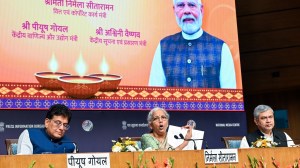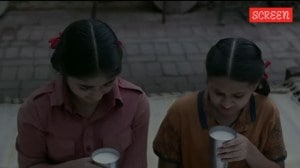They looked for life in a death trap
Rescue efforts by NDRF at mumbra in thane,where a building caved in on 130 residents
The first task of the National Disaster Response Force (NDRF) team was to establish control without upsetting locals,who were making frantic efforts to locate members of their families from the debris of a seven-storey building that had collapsed,with 130 people inside,at Shilphata at Mumbra in Thane on Thursday,April 4.
The NDRFs standard operating procedures are meant to be independent of local participation. Ideally,the site should have been cordoned,but the situation was very sensitive, says Alok Avasthy,commandant of the NDRFs 5th battalion,who led the team of nearly 100 men and three sniffer dogs from their base in Talegaon,off the Mumbai-Pune Expressway.
The locals were the first on the scene and everybody wanted to help, Avasthy says. We could not alienate them,but at the same time we could not allow locals to operate our machinery. In the end,we allowed them to transport the dead to ambulances.
Once the team had been briefed by the district administration,the operation began with a recce that classified the collapse as one of the pancake or sandwich kind,with survivors possibly trapped between the layers. Next came handling search and rescue with the delicacy such an operation needed.
We asked the JCB operators to stop the way they were digging without caution. There was every chance people would get injured, says Avasthy. We asked them to clear one large portion at a time so we could enter with our handheld equipment. It was a slow process,but people later understood.
Avasthy had led a team to Onagawa in Japan in 2011,after a tsunami had left several hundred thousand dead or homeless. The teams effort was acknowledged by then Japan Prime Minister Yoshihiko Noda when he visited India that December.
In Onagawa,we were looking for survivors in a multi-storey building and once the area was sealed,locals stayed at a distance, Avasthy says. In India,everyone wants their relatives to be rescued first,so the situation had to be handled very tactfully.
The NDRF in Pune is rarely called in after a building collapse. Handling this one was,however,beyond the means of the local team. We knew immediately that we would not be able to cope with it, says Santosh Kadam,head of Thane Municipal Corporations disaster management team.
When district officials told us some 130 people were thought trapped,we counted it as a level 3 disaster,which is beyond the capability of the state administration, says Avasthy.
The building had collapsed at 6 pm. The NDRF,which received the call at 7.20 pm,set off in 15 minutes two teams are always ready to move and reached the site in three hours,having been held up by traffic on the way. Kadam supervised operations during the crucial golden,or first,hour.
Search and rescue
To find survivors,the NDRF team used equipment called life detectors type-1 and type-2,programmed to detect the faintest of sounds from trapped people. Type-1 can go inside rubble while type-2 works from the surface and picks up human heartbeats. The beat of a human heart emits sound at 3 Hz. Life detector type-2 has a range of 500 metres and can detect a heartbeat beneath several feet, says Avasthy.
As the detectors looked for sound,sniffer dogs Urmi,Uday and Berkeley scoured the site for scent. Another team dug a small hole into a slab of concrete and lowered a rotating camera,attached to the end of a pole. The victim locator camera has a light and microphone so that rescuers can see and speak to victims, says Avasthy.
The exercise was repeated floor by floor,through the night. People were being moved out of the building every 15 minutes,according to Avasthy,and put into ambulances.
The work was at its most effective between midnight and dawn,with the crowd thinner and the sniffers and the equipment finding fewer distractions. Our dogs were not deployed all day long. They were first sent to the seventh floor. Once one dog scents a victim,we pull her out and send another to confirm that she has found a victim. They are pressed into action again after one floor has been cleared, says Avasthy.
It was an effort that eventually helped reunite people with their families,while ensuring the dead were removed with dignity.
The crucial periods were when we pulled someone out alive, Avasthy says. We had to assess their injuries,administer first aid and put them in an ambulance. This is when the most noise was made. As soon as someone was rescued,people would start shouting,Oye inko idhar lao,stretcher lao,ambulance lao.
Defeating death
Typically,a pancake collapse affords very little space for someone trapped to move about. Yet 62 people,many of them wedged in by concrete and metal on all sides and having virtually no air to breathe,were rescued,and many of them with minimal injuries.
One woman had nearly suffocated inside the rubble before she was rescued on Friday evening. When she stepped out,she took a deep breath. I think that was her first proper breath for more than 24 hours, Avasthy says.
The same evening,the rescue team freed a 58-year-old woman from between concrete slabs. Somehow,the only injury she had sustained was a cut near her mouth, says Pandit Ithape,deputy commandant,operations. It was difficult for someone her age to have survived that long,but she had somehow been able to breathe. We finally made an opening in the slab and extracted her slowly. Her husband and son did not survive.
Some children had been shielded by their parents as soon as the structure began to collapse. The luckier ones also had access to water by virtue of having been inside kitchens,and they managed to tough it out until help reached them.
I was hanging out near the main road while everyone else was inside, says Arif,13,as he shuffles between wards of Kalva Hospital,tending to his four younger siblings. There was a loud roar and the building disappeared all of a sudden. I ran towards it.
Of his siblings,Gulzar,6,Farzeen,4,and Airaz,3,managed to climb out of their fifth-floor home with minor injuries. The fourth sibling,Siddique,8,suffered a broken leg and had to be pulled out by rescue workers.
Mirza Mehmood Baig,40,was pinned to his bed by a slab of concrete that had fallen across his chest and legs. I was sleeping when the building began to shake. I thought an earthquake had struck and rolled over,when the slab fell where I was lying seconds earlier, says Baig,who sells milk for a living. Hours later,I heard the first sounds of rescuers and called out to them. They also managed to save a young girl who was trapped close by.
Baig escaped with bruises to his forehead,chest and back,and a sore neck. Only a few days ago,my wife had gone to her mothers home with our children. So they had a lucky escape.
For members of the NDRF team,the most satisfying experience was pulling out babies. Every time we managed to rescue someone,we were motivated to work even harder, Avasthy says. Operationally,the crucial period was 36 hours. When we pulled out a 30-year-old woman,we were very happy that we could dig her out alive after she had been trapped for so long.
Avasthy has overseen 56 rescue operations in four years,with 368 people rescued.
The Mumbra operation ended at 12.25 pm on Saturday,42 hours after the building had collapsed,with 72 bodies found. The team had expected it to stretch longer,having started digging into the foundation only at 9 am on Saturday,but broke through quicker than they had expected.
I dont think it was even constructed with concrete. It was a material that broke too easily, says Avasthy. What would have happened had 10 buildings collapsed? We wouldnt have been able to deal with that… The building was a seven-storey graveyard.
BERKELEY & TEAM
Berkeley is a seven-year-old female German Shepherd who worked on the site with Urmi and Uday. She played a key role in a nine-day operation in Bellary following a building collapse that killed 20 and injured 27. When sounds came from beneath the rubble,Berkeley was called upon to confirm it was from humans.
We strapped Berkeley to a harness and lowered her six feet into the building, says her trainer,Harihar Yadav. She began to bark when she spotted a man named Mallaya and we were able to pull him out alive,but his wife and children did not survive.
Mallaya had been trapped on one side of a wall,the rest of the family on the other. Also trapped was a dog,which delivered six puppies during the course of the operation.
The NDRFs Talegoan camp has 12 German Shephereds,who are chosen for rescue operations by turn and depending on fitness.
PRESSED FOR TIME
In Japan,we had no hope of finding anyone alive,so whenever we found a body,we would observe a minutes silence. That wasnt possible in Mumbra. We had to pull people out as fast as possible,so it was practically impossible to stop work-Alok Avasthy NDRF commandant



- 01
- 02
- 03
- 04
- 05




























